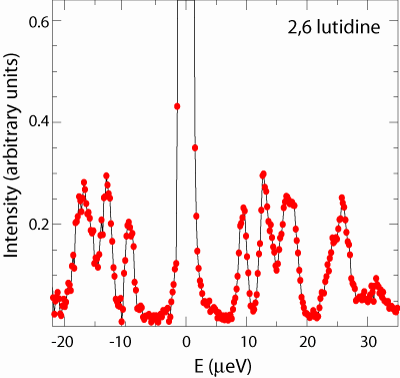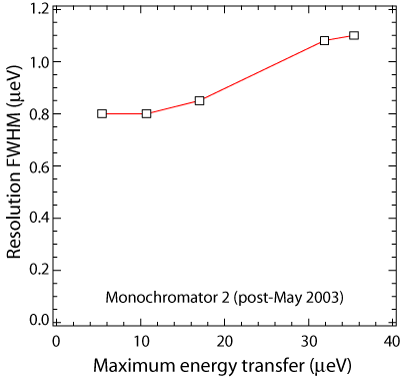HFBS Instrument Performance
HFBS: Performance and Data
The high-flux backscattering spectrometer located at the NIST Center for Neutron Research incorporates several state-of-the-art neutron optics devices (see the details webpage for more information) to achieve the highest possible flux on sample while maintaining an excellent energy resolution.
Vanadium resolution: Standard vanadium measured on the HFBS using a Doppler drive frequencyof 13.5 Hz (±36 µeV), and integrating over 0.6 Å-1 < Q < 1.6 Å-1. The solid line represents a fit to a Gaussian function plus a constant background. The spectrum shows an almost Gaussian-like energy resolution with a FWHM of 0.93 µeV.
HFBS resolution as a function of dynamic range: The resolution varies as the Doppler frequency changes. The plot above shows the resolution measured at different frequencies, i.e. different dynamic ranges.
At the center of the beam, the neutron fluence rate is 3 x 105 n cm-2 s-1 as determined by gold foil activation measurements. A high-speed Doppler-driven monochromator system allows energy transfers up to ±50 µeV (though this energy range is not advisable). The instrumental energy resolution is a Gaussian-like lineshape, with a full-width-half-maximum (FWHM) about 1 µeV.
Monitor performance
The use of a PST chopper introduces a change in the distribution of energies not uniform over the energy range. Below is shown the spectra of the monitor detector as a function of energy for largerst energy range that we use, 50 Hz or ±36 µeV
Monitor Performance: The energy distribution of energies based on the speed of the PST.
The distribution of neutron energies reflected from the PST chopper is skewed to energies greater than Eo, and this can be seen in the monitor spectrum above (more details on this can be found in the instrument paper). The monitor is located between the monochromator and the sample, and detects the neutrons before they hit the sample.
Examples
Below is an examples of HFBS experiment that benefit from the high resolution and increased flux.

A measurement of the methyl tunnel splitting in 2,6 lutidine (C7H9N) on the HFBS displays the large dynamic range as well as the excellent energy resolution (about 1.01 µeV FWHM at this dynamic range) of the instrument. The data has been summed over 10 detectors spanning 0.6 Å-1 and 1.6 Å-1.




